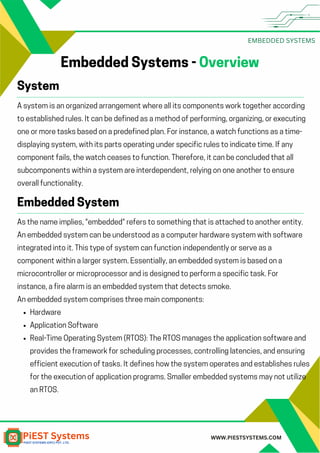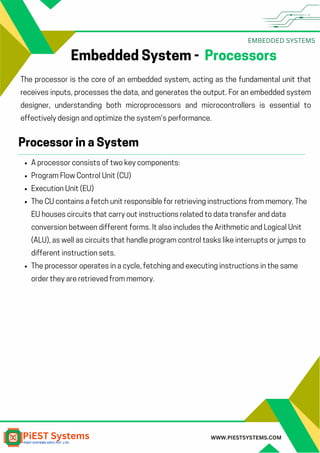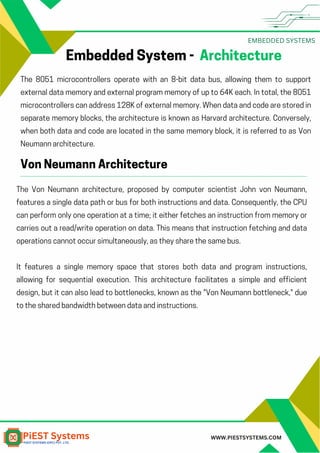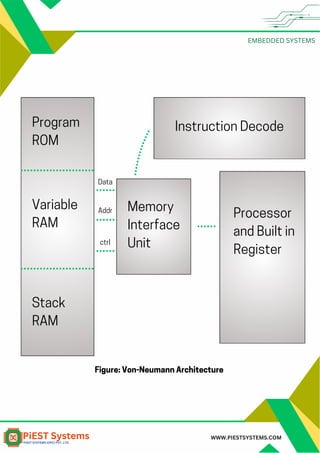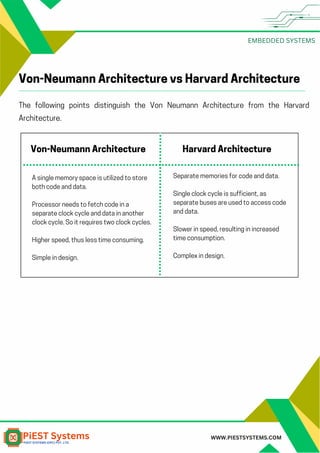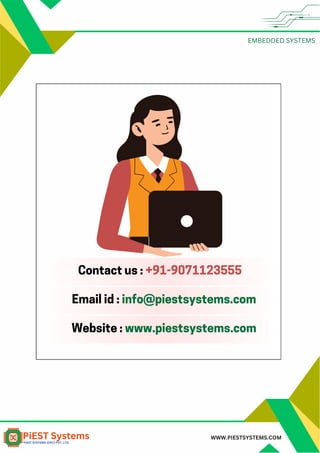Microprocessor vs. Microcontroller - Understand the Key Differences | Piest Systems
- 1. EMBEDDED SYSTEMS TRAINING PROGRAMS PIEST SYSTEMS WWW.PIESTSYSTEMS.COM
- 2. EMBEDDED SYSTEMS WWW.PIESTSYSTEMS.COM Piest Systems is a pioneering institution dedicated to advancing knowledge in Embedded Systems and Automotive Technologies. With a focus on providing high-quality training programs, Piest Systems equips engineers, freshers, and working professionals with essential skills in areas such as microcontroller programming, IoT integration, and advanced communication protocols. Our courses are designed to meet industry standards, ensuring participants are well-prepared for real-world challenges. Committed to excellence, Piest Systems is ISO 9001:2015 certified and has been recognized with a nomination for the India 5000 Best MSME Awards, underscoring our dedication to quality education and professional development in the technology sector. About the Piest Systems
- 3. EMBEDDED SYSTEMS WWW.PIESTSYSTEMS.COM Embedded Systems - Overview A system is an organized arrangement where all its components work together according to established rules. It can be defined as a method of performing, organizing, or executing one or more tasks based on a predefined plan. For instance, a watch functions as a time- displaying system, with its parts operating under specific rules to indicate time. If any component fails, the watch ceases to function. Therefore, it can be concluded that all subcomponents within a system are interdependent, relying on one another to ensure overall functionality. System As the name implies, "embedded" refers to something that is attached to another entity. An embedded system can be understood as a computer hardware system with software integrated into it. This type of system can function independently or serve as a component within a larger system. Essentially, an embedded system is based on a microcontroller or microprocessor and is designed to perform a specific task. For instance, a fire alarm is an embedded system that detects smoke. An embedded system comprises three main components: Hardware Application Software Real-Time Operating System (RTOS): The RTOS manages the application software and provides the framework for scheduling processes, controlling latencies, and ensuring efficient execution of tasks. It defines how the system operates and establishes rules for the execution of application programs. Smaller embedded systems may not utilize an RTOS. Embedded System
- 4. EMBEDDED SYSTEMS WWW.PIESTSYSTEMS.COM In summary, an embedded system is a microcontroller-based, software-driven, reliable, real-time control system. Single-Functionality : An embedded system typically performs a specialized function and executes it repeatedly. For example, a pager is dedicated solely to its primary function of messaging. Tightly Constrained : While all computing systems face design constraints, those for embedded systems are often particularly strict. Design metrics, which measure features such as cost, size, power consumption, and performance, must be optimized. The system should be compact enough to fit on a single chip, fast enough to process data in real-time, and energy-efficient to prolong battery life. Reactive and Real-Time : Many embedded systems are designed to continuously respond to changes in their environment and deliver results in real-time without delays. For instance, a car's cruise control system constantly monitors speed and brake sensors, calculating acceleration or deceleration within a strict timeframe. Delayed computations in this context can compromise vehicle control. Microprocessor-Based : Embedded systems rely on microprocessors or microcontrollers for their operation. Memory : They typically contain memory, as the software is often embedded in Read- Only Memory (ROM). Secondary memory is generally unnecessary. Connected : Embedded systems feature connected peripherals to interface with input and output devices. HW-SW Systems : They utilize software to enhance functionality and flexibility while employing hardware to ensure performance and security. Characteristics of an Embedded System
- 5. EMBEDDED SYSTEMS WWW.PIESTSYSTEMS.COM ASIP & ASIC PROCESSOR CORE ANALOG I/O DIGITAL I/O MEMORY
- 6. EMBEDDED SYSTEMS WWW.PIESTSYSTEMS.COM Advantage Easily Customizable Low Power Consumption Low Cost Enhanced Performance Disadvantage High development effort Larger time to market Basic Structure of an Embedded Systems Sensor A-D Converter Processor & ASIC D-A Converter Actuator Memory
- 7. EMBEDDED SYSTEMS WWW.PIESTSYSTEMS.COM Sensor : A sensor detects a physical quantity and converts it into an electrical signal, which can be read by an observer or processed by an electronic device, such as an Analog-to-Digital (A2D) converter. It also stores the measured value in memory. A-D Converter : The Analog-to-Digital converter transforms the analog signal from the sensor into a digital signal that can be processed. Processor & ASICs : The processor analyzes the digital data, calculates the output, and stores the result in memory. D-A Converter : A Digital-to-Analog converter converts the digital output from the processor into an analog signal. Actuator : The actuator compares the analog output from the D-A converter to the expected value, then stores and applies the approved result.
- 8. EMBEDDED SYSTEMS WWW.PIESTSYSTEMS.COM Embedded System - Processors The processor is the core of an embedded system, acting as the fundamental unit that receives inputs, processes the data, and generates the output. For an embedded system designer, understanding both microprocessors and microcontrollers is essential to effectively design and optimize the system's performance. A processor consists of two key components: Program Flow Control Unit (CU) Execution Unit (EU) The CU contains a fetch unit responsible for retrieving instructions from memory. The EU houses circuits that carry out instructions related to data transfer and data conversion between different forms. It also includes the Arithmetic and Logical Unit (ALU), as well as circuits that handle program control tasks like interrupts or jumps to different instruction sets. The processor operates in a cycle, fetching and executing instructions in the same order they are retrieved from memory. Processor in a System
- 9. EMBEDDED SYSTEMS WWW.PIESTSYSTEMS.COM Processors can be categorized as follows: General Purpose Processors (GPP): Microprocessor Microcontroller Embedded Processor Digital Signal Processor (DSP) Media Processor Application Specific System Processor (ASSP) Application Specific Instruction Processors (ASIPs) GPP Core(s) or ASIP Core(s) integrated into an Application Specific Integrated Circuit (ASIC) or a Very Large Scale Integration (VLSI) circuit. Types of Processors
- 10. EMBEDDED SYSTEMS WWW.PIESTSYSTEMS.COM A microprocessor is a single VLSI chip having a CPU. In addition, it may also have other units such as coaches, floating point processing arithmetic unit, and pipelining units that help in faster processing of instructions. Earlier generation microprocessors’ fetch-and- execute cycle was guided by a clock frequency of order of ~1 MHz. Processors now operate at a clock frequency of 2GHz Microprocessor CPU Genearl Purpose Microprocesoor RAM ROM I/O PORT TIMER SERIAL COM PART A Simple Block Diagram Of Microprocessor
- 11. EMBEDDED SYSTEMS WWW.PIESTSYSTEMS.COM A microcontroller is a single-chip Very Large Scale Integration (VLSI) device, often referred to as a microcomputer. While it has limited computational power, it offers enhanced input/output capabilities and includes several on-chip functional units, making it highly versatile for various embedded applications. Microcontroller CPU RAM ROM I/O PORT TIMER SERIAL COM PORT Microcontroller Chip
- 12. EMBEDDED SYSTEMS WWW.PIESTSYSTEMS.COM Let us now take a look at the most notable differences between a microprocessor and a microcontroller. Microcontroller VS Microcontroller Microprocessor Microcontroller Microprocessors are designed for multitasking, allowing them to perform multiple tasks simultaneously. For instance, on a computer, you can play music while typing in a text editor. RAM, ROM, I/O ports, and timers can be added externally and their quantities can vary depending on the system's requirements. Designers have the flexibility to determine the required number of memory units or I/O ports. The addition of external memory and I/O ports increases the complexity and cost of a microprocessor-based system. External devices take up more space and have higher power consumption. Single-task oriented systems are designed to perform one specific function. For example, a washing machine is built solely for washing clothes. RAM, ROM, I/O ports, and timers cannot be added externally. These components are embedded together on a chip with fixed quantities A fixed amount of memory and I/O makes a microcontroller well-suited for performing specific, limited tasks efficiently. Microcontrollers are more lightweight and cost-effective compared to microprocessors. A microcontroller-based system is more power-efficient and occupies less space.
- 13. EMBEDDED SYSTEMS WWW.PIESTSYSTEMS.COM Embedded System - Architecture The 8051 microcontrollers operate with an 8-bit data bus, allowing them to support external data memory and external program memory of up to 64K each. In total, the 8051 microcontrollers can address 128K of external memory. When data and code are stored in separate memory blocks, the architecture is known as Harvard architecture. Conversely, when both data and code are located in the same memory block, it is referred to as Von Neumann architecture. Von Neumann Architecture The Von Neumann architecture, proposed by computer scientist John von Neumann, features a single data path or bus for both instructions and data. Consequently, the CPU can perform only one operation at a time; it either fetches an instruction from memory or carries out a read/write operation on data. This means that instruction fetching and data operations cannot occur simultaneously, as they share the same bus. It features a single memory space that stores both data and program instructions, allowing for sequential execution. This architecture facilitates a simple and efficient design, but it can also lead to bottlenecks, known as the "Von Neumann bottleneck," due to the shared bandwidth between data and instructions.
- 14. EMBEDDED SYSTEMS WWW.PIESTSYSTEMS.COM Program ROM Variable RAM Stack RAM Data Addr ctrl Memory Interface Unit Processor and Built in Register Instruction Decode Figure: Von-Neumann Architecture
- 15. EMBEDDED SYSTEMS WWW.PIESTSYSTEMS.COM Harvard Architecture The Harvard architecture features distinct storage and signal buses for instructions and data. In this architecture, data storage is entirely located within the CPU, preventing access to instruction storage as if it were data. Computers utilizing this architecture have separate memory areas for program instructions and data, enabling simultaneous access to both. Programs had to be loaded by an operator, as the processor was unable to boot itself. In the Harvard architecture, it is unnecessary for the two types of memory to share characteristics.
- 16. EMBEDDED SYSTEMS WWW.PIESTSYSTEMS.COM Control Space Program ROM Instruction Decode PC Stack Processor & Register Interface Data Addr Ctrl Data Addr Ctrl Register Space Figure: Harvard Architecture
- 17. EMBEDDED SYSTEMS WWW.PIESTSYSTEMS.COM Von-Neumann Architecture vs Harvard Architecture The following points distinguish the Von Neumann Architecture from the Harvard Architecture. Von-Neumann Architecture Harvard Architecture A single memory space is utilized to store both code and data. Processor needs to fetch code in a separate clock cycle and data in another clock cycle. So it requires two clock cycles. Higher speed, thus less time consuming. Simple in design. Separate memories for code and data. Single clock cycle is sufficient, as separate buses are used to access code and data. Slower in speed, resulting in increased time consumption. Complex in design.
- 18. EMBEDDED SYSTEMS WWW.PIESTSYSTEMS.COM CISC and RISC CISC (Complex Instruction Set Computer) and RISC (Reduced Instruction Set Computer) are two different architectures used in computer design, each with its own characteristics and advantages. CISC (Complex Instruction Set Computer) Definition : CISC architecture is designed to execute a large number of instructions, allowing for more complex operations within a single instruction. Instruction Set : It has a rich instruction set, which can perform multiple tasks in a single instruction, such as loading data from memory, performing arithmetic operations, and storing results. Examples : Common examples of CISC architectures include the x86 family of processors. Advantages : Compact Code : Since each instruction can perform multiple operations, programs tend to have smaller code sizes. Complex Operations: It can handle complex tasks without requiring many instructions. Disadvantages : Slower Execution: The complexity of the instructions can lead to slower execution times due to longer decoding and execution cycles. Higher Power Consumption: The more complex circuitry can consume more power.
- 19. EMBEDDED SYSTEMS WWW.PIESTSYSTEMS.COM RISC (Reduced Instruction Set Computer) Definition : RISC architecture focuses on a smaller set of simpler instructions, designed to be executed in a single clock cycle. Instruction Set : It uses a limited number of instructions, typically of a fixed length, emphasizing efficiency and speed. Examples : Examples include ARM, MIPS, and PowerPC architectures. Advantages : Faster Execution: Simpler instructions can be executed more quickly, often in one clock cycle, leading to better performance. Lower Power Consumption: Less complex circuitry generally results in lower power consumption. Disadvantages : Larger Code Size : Programs may require more instructions to perform the same task, resulting in larger code sizes. More Compiler Work : Requires advanced compilers to optimize the use of the limited instruction set effectively.
- 20. EMBEDDED SYSTEMS WWW.PIESTSYSTEMS.COM CISC and RISC RISC Larger set of instructions. Easy to program. Simpler design of compiler, considering larger set of instructions. Many addressing modes causing complex instruction formats Instruction length is variable. Higher clock cycles per second. Emphasis is on hardware. Control unit implements large instruction set using micro-program unit. Slower execution, as instructions are to be read from memory and decoded by the decoder unit. Pipelining is not possible. Smaller set of Instructions. Difficult to program. Complex design of compiler. Few addressing modes, fix instruction format Instruction length varies. Low clock cycle per second. Emphasis is on software. Each instruction is to be executed by hardware. Faster execution, as each instruction is to be executed by hardware. Pipelining of instructions is possible, considering single clock cycle. The following points differentiate a CISC from a RISC – CISC
- 21. EMBEDDED SYSTEMS WWW.PIESTSYSTEMS.COM Contact us : +91-9071123555 Email id : [email protected] Website : www.piestsystems.com



